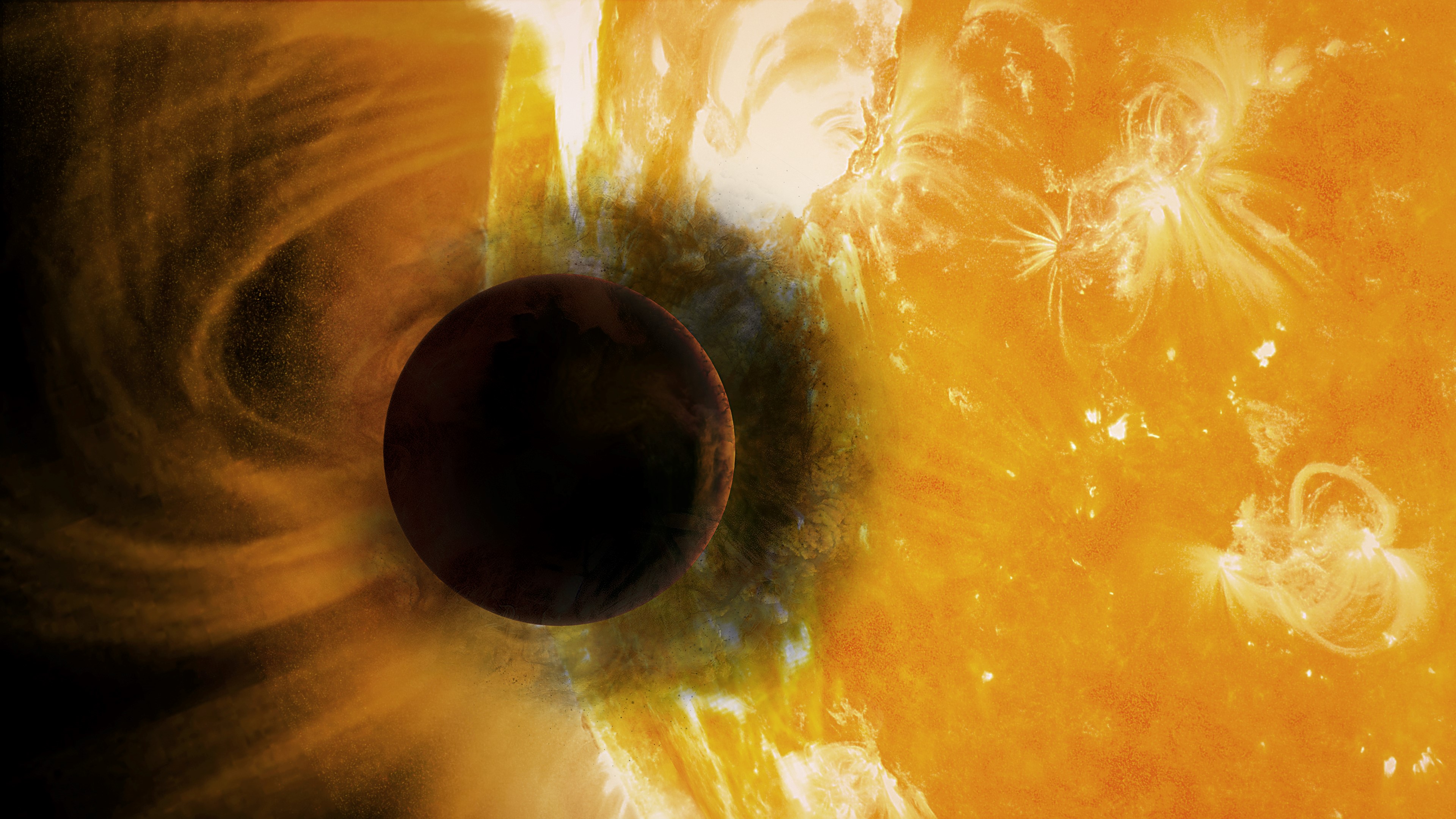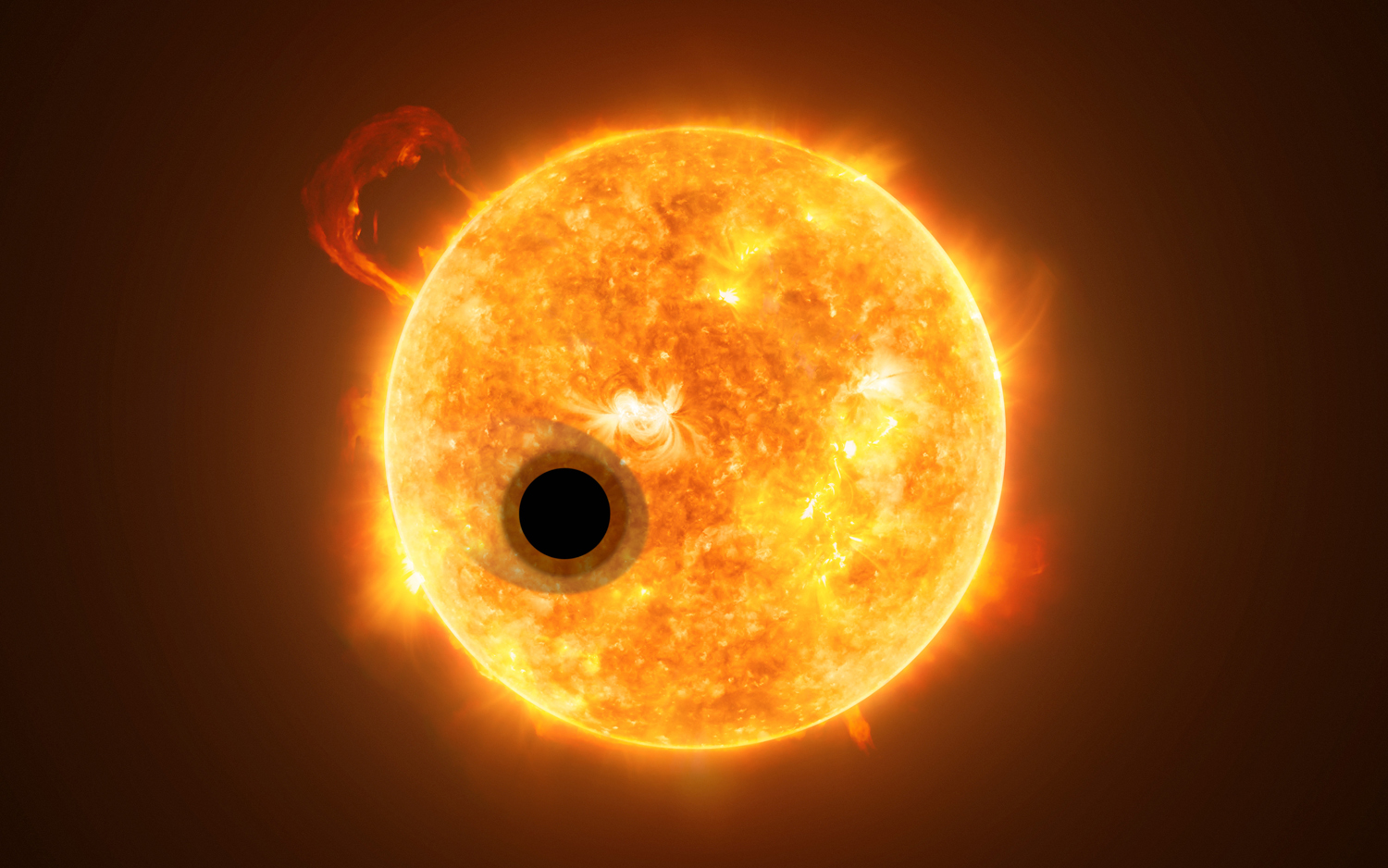An Exoplanet First! Helium Spotted on Bizarre Comet-Like World
Understanding the weather on alien planets just got a little less complicated.
For the first time, astronomers have detected helium in the atmosphere of an alien world, a new study reports. The discovery shows that it's possible to probe the air of at least some exoplanets without launching a new space telescope dedicated to this endeavor, the researchers said.
"This is a new method to probe the upper parts of an exoplanet atmosphere, where high-energy radiation is observed," study lead author Jessica Spake, an exoplanet hunter at the University of Exeter in England, told Space.com via email. "Hopefully, we'll be able to study many more upper planetary atmospheres this way." [Gallery: The Strangest Alien Planets]

Revealing the unseen
To study the atmosphere of a faraway planet, scientists must wait for it to pass between its host star and Earth. Just before and after the bulk of the planet blocks some of the light streaming from the star, some of that light passes through the world's atmosphere. By studying how the light from the star changes as it passes through that alien air, scientists are able to characterize the atmosphere's composition.
The process is difficult, and scientists have probed only a handful of worlds' atmospheres in this manner to date. So far, the study of exoplanet air has focused on hydrogen, the most abundant element in the universe and one of the main constituents of the solar system's gas giants. Early theoretical models predicted that helium should be among the most easily spotted elements in exoplanet atmospheres, but until now, it has remained unseen.
Enter WASP-107b, a super-Neptune world that lies 200 light-years from Earth in the constellation of Virgo. Discovered in 2017, the gas giant is comparable in diameter to Jupiter but has just one-eighth of Jupiter's mass, making it one of the lowest-density worlds known.

WASP-107b lies about eight times closer to its star than Mercury does to the sun, completing one orbit every 5.7 Earth days. At a sweltering 932 degrees Fahrenheit (500 degrees Celsius), this planet's atmosphere is one of the hottest among any known exoplanet.
Get the Space.com Newsletter
Breaking space news, the latest updates on rocket launches, skywatching events and more!
Spake and her colleagues turned NASA's Hubble Space Telescope toward the overheated world to study it in infrared wavelengths. By analyzing the light passing through WASP-107b's atmosphere, the researchers were able to identify helium in its excited state. This was possible thanks to a quirk of quantum mechanics that kept the element's electrons at a higher-energy state for more than 2 hours instead of a handful of nanoseconds.
This focus on infrared light was key, the researchers said. Previous measurements of exoplanet atmospheres have relied on ultraviolet (UV) light, which Earth's atmosphere largely blocks. But infrared radiation passes through our air and clouds, meaning ground-based scopes can pick it up.
Hubble isn't the only tool that astronomers can use for such infrared work. Spake said that NASA's $8.8 billion James Webb Space Telescope, which is scheduled to launch in May 2020, will likely be able to make similar observations, as will ground-based instruments like the European Southern Observatory's Very Large Telescopein Chile, the Telescopio Nazionale Galileoin the Canary Islands and the Keck telescopesin Hawaii. [Photos: Hubble's Successor, the James Webb Space Telescope]
In contrast, only a single space-based telescope has been capable of probing exoplanet atmospheres in the ultraviolet.
"UV observations are … technically difficult, and only Hubble can do them right now," Spake said. "That's the main reason only a handful of upper atmospheres have been studied so far."
The research was published online today (May 2) in the journal Nature.

Comet-like world
WASP-107b is a great world to study with the new method, because a large quantity of the exoplanet's atmosphere is being lost to space. The researchers determined that ultraviolet radiation from WASP-107b's star is stripping away the planet's air, resulting in a long, comet-like tail on the world.
"The helium we detected extends far out to space as a tenuous cloud surrounding the planet," study co-author Tom Evans, also of the University of Exeter, said in a statement.
The abundance of helium doesn't mean that WASP-107b lacks hydrogen, team members added.
"I think we'd expect hydrogen to be dominant in the atmosphere of WASP-107b," Spake said. "We just haven't directly detected it on this planet yet."
The new method will also allow researchers to study planets farther away from our sun than could be probed in the ultraviolet, Spake said. Clouds of hydrogen in space can absorb UV light across longer distances, so UV studies generally must look in Earth's cosmic backyard. Infrared wavelengths, on the other hand, easily pass through hydrogen clouds, allowing for the examination of planets at greater distances.
So far, the study of exoplanet atmospheres has focused on "hot Jupiters," the bloated gas giants that orbit their suns in mere days or even hours. Spake said that's because larger atmospheres are easier to study. WASP-107b's atmosphere has a height of about 620 miles (1,000 kilometers); for comparison, about 99 percent of Earth's air is found within 20 miles (32 km) of the ground.
But a cloud of escaping helium could make it easier to study the atmospheres of smaller, rockier worlds, study team members said.
"If smaller, Earth-sized planets have similar helium clouds, this new technique offers an exciting means to study their upper atmospheres in the very near future," Evans said.
Follow Nola Taylor Redd at @NolaTRedd, Facebook, or Google+. Follow us at @Spacedotcom, Facebookor Google+. Originally published on Space.com.
Join our Space Forums to keep talking space on the latest missions, night sky and more! And if you have a news tip, correction or comment, let us know at: community@space.com.

Nola Taylor Tillman is a contributing writer for Space.com. She loves all things space and astronomy-related, and enjoys the opportunity to learn more. She has a Bachelor’s degree in English and Astrophysics from Agnes Scott college and served as an intern at Sky & Telescope magazine. In her free time, she homeschools her four children. Follow her on Twitter at @NolaTRedd









